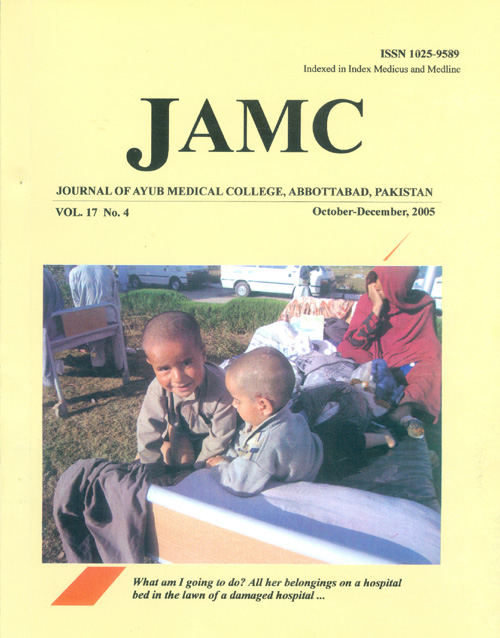EFFECT OF PROVIDING FREE SPUTUM MICROSCOPY SERVICE TO PRIVATE PRACTITIONERS ON CASE NOTIFICATION TO NATIONAL TUBERCULOSIS CONTROL PROGRAM
Abstract
Background: This study was undertaken to see whether providing free sputum microscopyservices to private practitioners helps in case notification to the national tuberculosis controlprogram. The knowledge, attitudes and practices of these practitioners regarding tuberculosis werealso evaluated. Methods: A questionnaire was administered to all the private practitionerspracticing in a densely populated area of Karachi. They were asked to fill tuberculosis notificationcards for the first three months and then for another three months when an incentive in the form offree sputum microscopy was provided to the practitioners. Results: Although the majority of thepractitioners knew that cough, fever and weight loss are the main symptoms of tuberculosis, lessthan half knew that blood in sputum, poor appetite and chest pain could also be associated withtuberculosis. Only 66% of the practitioners indicated sputum microscopy as the preferreddiagnostic method for tuberculosis. Only 50% of the practitioners self treated the patients, whilethe remaining half referred their patients to specialists. Around 80% of the practitioners wereaware of the four first-line anti-tuberculosis drugs. Less than half of the practitioners consideredsputum microscopy as the most useful follow-up investigation in a patient with pulmonarytuberculosis. Generally, there was a poor response in case notification by private practitioners onprovision of free sputum microscopy. Conclusion: An overwhelming majority of the practitionershad poor knowledge concerning the correct treatment practices in Tuberculosis. Providing sputumfree microscopy does not significantly help in improving tuberculosis case notification. Strategiesfor public-private collaboration in tuberculosis control are needed.Keywords: tuberculosis, private practice, sputum, microscopy, knowledge, attitude, behaviour,Pakistan.References
De Muynck A, Siddiqi S, Ghaffar A, Sadiq H. Tuberculosis
control in Pakistan. Critical analysis and its implementation.
J Pak Med Assoc 2001;51:41-7.
Country Profile: Pakistan; Global Tuberculosis Control.
WHO Report 2003, pp 99-101.
Introduction; National Guidelines for TB Control in Pakistan,
, pp 1-3.
Marsh D, Hashim R, Hassany F, Hussain N, Iqbal Z,
Irfanullah A et al. Frontline management of tuberculosis and
treatment practices in urban Sindh, Pakistan. Tuber Lung Dis
;77:86-92.
Bennet, S., McPake, B., Mills, A. The public/private mixed
debate in health care. In:Benet, S., McPake, B., Mills, A.
(eds). Private Health Providers in Developing Countries.
Serving the Public Interest? Zed Books Ltd 1997; London:
pp. 1-18.
Hurtig AK, Pande SB, Baral SC, Porter JD, Bam DS.
Tuberculosis treatment and private practioners in Kathmandu
Valley. Int J Tuberc Lung Dis 2000;4:730-6.
Uplekar MW, Shepard DS. Treatment of tuberculosis by
private practitioners in India. Tuberculosis 1991;72:284-290.
Uplekar MW, Rangan S. Tackling TB – the search for
solutions. The Foundation for Research in Community
Health. 1996; Pune/ Mumbai, India.
Hong YP, Kwon DW, Kim SJ, Chang SC, Kang MK, Lee EP
et al. Survey of knowledge, attitudes and practices for
tuberculosis among general practitioners. Tuber Lung Dis
;76:431-5.
Uplekar MW, Rangan S. Private doctors and tuberculosis
control in India. Tuber Lung Dis 1993;74:332-7.
Dolin PJ, Raviglione MC, Kochi A. Global TB incidence and
mortality during 1990-2000. Bull World Health Organ
;72:213-20.
Singla N, Sharma PP, Singla R, Jain RC. Survey of
knowledge, attitude and practices for tuberculosis among
general practitioners in Delhi, India. Int J Tuberc Lung Dis
;2:384-9.
Hussain R, Hasan R, Khurshid M, Sturm AW, Ellner JJ,
Dawood G. Pulmonary TB in a BCG vaccinated area:
Relationship of disease and drug with immunological and
hematological parameters and drug resistance. Southeast
Asian J Trop Med Public Health 1996;27:257-62.
Grzybowski A. Tuberculosis, a look at the world situation.
In: Pathan AJ, Illyas eds. Jan’s treatise on epidemiology and
control on tuberculosis, Karachi: Time Traders,1988;pp 62
Hossain S. TB: A public health threat as NATAB sees it.
Presented at 28th World Conference of IUTALD/UICTMR
Mainz, Germany, June 14-17, 1994.
Issue
Section
License
Journal of Ayub Medical College, Abbottabad is an OPEN ACCESS JOURNAL which means that all content is FREELY available without charge to all users whether registered with the journal or not. The work published by J Ayub Med Coll Abbottabad is licensed and distributed under the creative commons License CC BY ND Attribution-NoDerivs. Material printed in this journal is OPEN to access, and are FREE for use in academic and research work with proper citation. J Ayub Med Coll Abbottabad accepts only original material for publication with the understanding that except for abstracts, no part of the data has been published or will be submitted for publication elsewhere before appearing in J Ayub Med Coll Abbottabad. The Editorial Board of J Ayub Med Coll Abbottabad makes every effort to ensure the accuracy and authenticity of material printed in J Ayub Med Coll Abbottabad. However, conclusions and statements expressed are views of the authors and do not reflect the opinion/policy of J Ayub Med Coll Abbottabad or the Editorial Board.
USERS are allowed to read, download, copy, distribute, print, search, or link to the full texts of the articles, or use them for any other lawful purpose, without asking prior permission from the publisher or the author. This is in accordance with the BOAI definition of open access.
AUTHORS retain the rights of free downloading/unlimited e-print of full text and sharing/disseminating the article without any restriction, by any means including twitter, scholarly collaboration networks such as ResearchGate, Academia.eu, and social media sites such as Twitter, LinkedIn, Google Scholar and any other professional or academic networking site.









